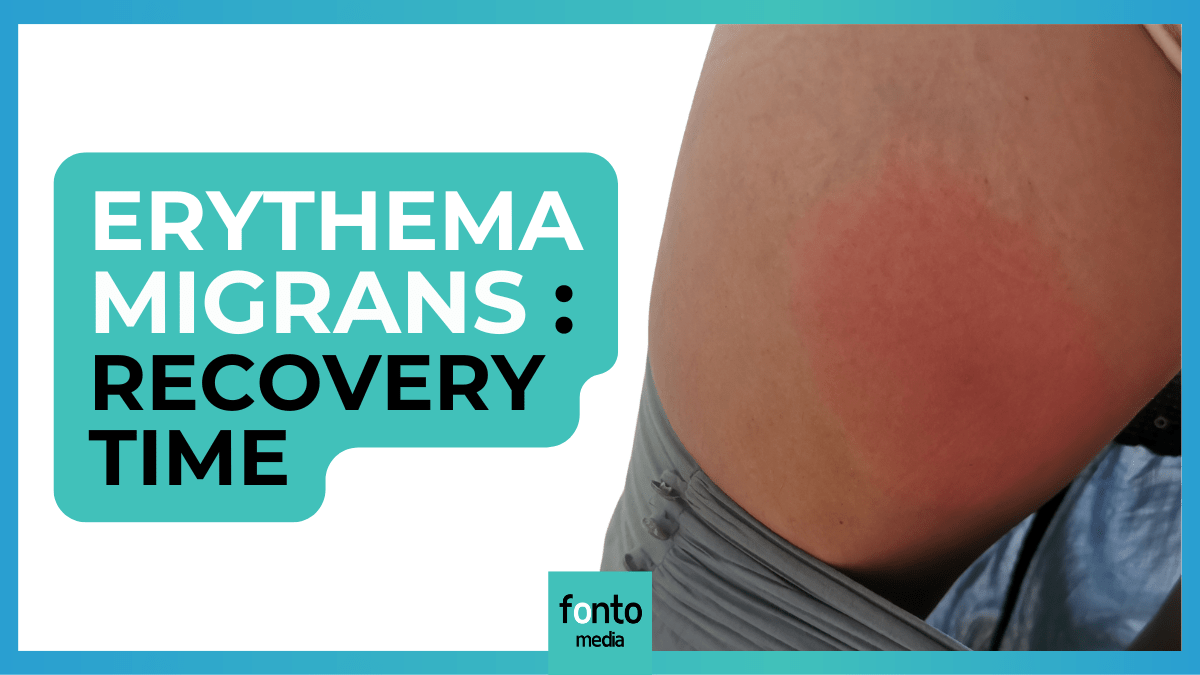♻️ Last update: September 5, 2025.
👩⚖️ Declaration of financial interests: none directly related to the subject. My complete declaration of financial interests is in the legal notice section.
Written by Nelly Darbois, physiotherapist and scientific editor
How to recognize erythema migrans? Diagnosis and symptoms
Erythema migrans appears between 1 and 28 days after the tick bite (most often between 7 and 14 days), if the tick has transmitted Lyme disease (also known as Lyme borreliosis).
It’s a red patch that spreads progressively, often in a ring, with a lighter center. Fever may be associated.
This is the most visible (and mildest) symptom of Lyme disease, transmitted by deer ticks.
It can be :
- single or multiple (rarer);
- circular or irregular ;
- located around the puncture site or elsewhere on the body.
Diagnosis is clinical, based on simple observation by the doctor: no examination is necessary to confirm it if the doctor finds the typical signs and there is a context of tick bite.
Don’t confuse this with a simple tick bite mark, which is usually very small (1 or 2 cm) and requires no special care.
In 1/3 of cases, erythema migrans goes unnoticed. But when you think it’s erythema migrans, you’re right in 9 out of 10 cases (National Guideline 2018).
2 out of 10 patients develop an early disseminated form, the most frequent symptom being the presence of several erythema migrans lesions (Skar 2024).
Other symptoms of Lyme disease that may appear at this stage are :
- general malaise,
- headaches,
- fever,
- muscle and joint pain.

Do I need to take a blood test?
Erythema migrans can be diagnosed without further examination, as it is very typical.
What’s more, serologies (blood tests) are often negative in the early weeks of Lyme disease. They are therefore not useful for making a diagnosis at this stage.
Your doctor may suggest them at a later date, or if in doubt about a more widespread form of Lyme disease.
No need for a biopsy either!

Does erythema migrans hurt or itch?
Erythema can cause a burning or itching sensation, or be completely painless.
In all cases, these are not signs of complication or severity.
Does a person with erythema migrans necessarily have Lyme disease?
Erythema migrans is specific to Lyme disease, although not all sufferers develop it (7 out of 10 people with the disease have erythema migrans; Skar 2024).
In other words, if you have erythema migrans, you definitely have Lyme disease. But rest assured: it doesn’t mean you’re going to have complications.
On the contrary, erythema migrans is a good thing, as it allows treatment to be started quickly.
How is erythema migrans treated?
Treatment of erythema migrans is based on antibiotics, prescribed for 10 days to 2 weeks, from the first day of erythema’s appearance:
- doxycycline as first-line treatment;
- other antibiotics in case of allergy or special situation.
This treatment helps to avoid the complications of Lyme disease (neurological, articular, etc.).
Doxycyline should be avoided in the sun, as it can cause severe sunburn.
How long does it take for erythema migrans to disappear?
The eruption tends to extend over several days, with concentric rings sometimes visible.
Left untreated, the erythema may persist for 2 to 3 weeks, reaching up to 20 cm in diameter.
In 2 out of 10 people, the erythema migrans disappears and then reappears several times.

In general, erythema begins to fade a few days after the start of treatment, and disappears completely within 1 to 4 weeks.
It can sometimes persist for a little longer or leave a slight trace. This does not usually mean that the treatment has failed.
***
That’s all I wanted to say on the subject! Any questions or comments? See you in comments!
📚 SOURCES
National Guideline Centre (UK). Evidence review for diagnostic accuracy of signs and symptoms: Lyme disease: diagnosis and management: Evidence review B. London: National Institute for Health and Care Excellence (NICE); 2018 Apr. (NICE Guideline, No. 95.) Available from: https://www.ncbi.nlm.nih.gov/books/NBK578133/
Skar GL, Blum MA, Simonsen KA. Lyme Disease. [Updated 2024 Oct 1]. In: StatPearls [Internet]. Treasure Island (FL): StatPearls Publishing; 2025 Jan-. Available from: https://www.ncbi.nlm.nih.gov/books/NBK431066/
Schotthoefer AM, Green CB, Dempsey G, Horn EJ. The Spectrum of Erythema Migrans in Early Lyme Disease: Can We Improve Its Recognition? Cureus. 2022 Oct 25;14(10):e30673. doi: 10.7759/cureus.30673. PMID: 36439577; PMCID: PMC9687974.

Written by Nelly Darbois
I enjoy writing articles that answer your questions, drawing on my experience as a physiotherapist and scientific writer, as well as extensive research in international scientific literature.
I live in the French Alps☀️🏔️, where I enjoy the simple pleasures of life (+ I’m a Wikipedia consultant and the founder of Wikiconsult).









